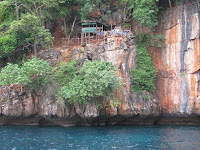The seas house many unimaginable wonders of the world. Starting from the colors of the water, to the colors of the seabed, to the variety of organisms, colors of them are all mind-boggling wonders. A travel to the sea always reminds that the earth, however netted by the internet, is still big and has a lot to be explored. In the last 6 months, I have had the chance to visit two different seas: The South China Sea along Bintan, Indonesia and the Andaman Sea along Phuket, Thailand. The two places where very very exotic and different in their own way. At the outset, Bintan had clear blue waters while Phuket had Turquoise blue waters. See the pictures below: The first one is Bintan, and the next one is Phuket.
This color difference was the one that I noticed first. It was exotic to see turquoise blue waters in Phuket. One could note that even as one is flying into Phuket. In contrast, the waters in Bintan were clear blue. The reason, I learned later, was due to the fact that Phuket waters contain more of lime dissolved in them and the sea bed is made of limestone. The dissolved lime and the seabed, contribute to this color of the water. Water, in itself, does not have any color. But the dissolved particles, or the surface beneath, when reflecting/refracting the light from the sun, gives such a color to the water. The reddish color of certain other seas, I learn, is because of the ion content dissolved in them. So, the color of the ocean tells us about the ecology in that area!
I also noticed that the corals in Phuket (during snorkelling) were more colorful and housed more fishes than that we saw in Bintan. This could be due to several reasons. The one we saw in Bintan was shallower than the ones we saw in Phuket. A deeper sea could have more colorful corals. Maybe. But I did notice that there were huge schools of fishes in Phuket than in Bintan. I don't know why. But it was a little frightening to see huge swarms of fishes! :-) The colors of the fishes, I just couldn't believe my eyes. I don't know if we can reproduce such colors in paintings! In their natural setting, the colors were awesome.
The next thing I noticed was the huge limestone rock mountains in the Phuket seas. It seems that these limestone rocks are there for over several thousand years. The calcium deposition during the ice age, along with volcanic activities, they say, had shaped the current geology of the area. Bintan, on the other hand, was just like the seas that we know of usually. A large landscape with no interrupting rocks or mountains. What was more interesting is that, these large limestone rocks, sometimes looked as though somebody had taken a huge knife and just sliced it apart! That was intriguing. But later I learnt that since the limestones are inelastic, when the seabed underneath undergoes an expansion, the rocks just split apart, unlike sand mountains which would slide and make an even topography. See the photo below. This may not be the best picture, but still you can appreciate that this particular side of the rock has been just sliced off as though you cut an apple into two halves.
There are several studies on the geology of the andaman sea. This one 'The Andaman Sea Rocks' is a good start to read about them.
That's so much I have to say about the landscapes I have seen in the two places.
Corals, the organisms that give the landscape of the sea, are interesting in their own. Their way of living, their physiology, their anatomy, their symbiotic modes of living are way intriguing. Wikipedia has lots of interesting information on it...so, I don't think I should reproduce the information. But anybody who is going to snorkeling or diving, should first read about the corals. You will then be able to appreciate the beauty and the lifestyle of these organisms much better!
PS: The photos I have provided here were taken by my friend, Santio Ruban. So, if you want any of them, please contact him.



No comments:
Post a Comment